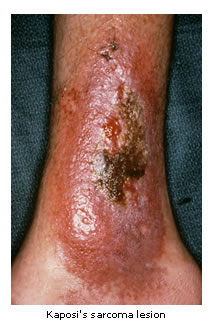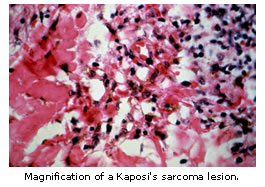Kaposi's Sarcoma
Kaposi's sarcoma is a form of skin cancer usually
found in AIDS (acquired immunodeficiency syndrome)
patients and other patients with immune deficiency disorders.
Symptoms of Kaposi's Sarcoma
The symptoms of Kaposi's sarcoma are:
- Flat patches
- Bruise-like in appearance (red, purple, brown, and blue in
color)
- Pea-sized and larger lesions that can grow to cover a large
part of the skin
Kaposi's sarcoma can spread internally to the lymph nodes and
internal organs, thus causing serious and life-threatening conditions.


Who Gets It?
About a quarter of AIDS patients who get AIDS through sexual
transmission get Kaposi's sarcoma. In these patients, the Kaposi's
sarcoma lesions usually occur in the upper body.
When it was first discovered before the AIDS epidemic, Kaposi's
sarcoma lesions develop in the legs. This rare form of the disease,
called classic Kaposi's sarcoma, afflicts mostly
healthy older Italian and Jewish males.
Treatment of Kaposi's Sarcoma?
For small lesions, the treatments for this condition are:
- Local injection of chemotherapy agents
- Freezing with liquid nitrogen
For larger patches and if there is infection of the lymph nodes
or internal organs, the treatments include:
- Chemotherapy
- Radiation therapy


